Alopecia Areata: Causes, Symptoms & Best Treatments in 2025
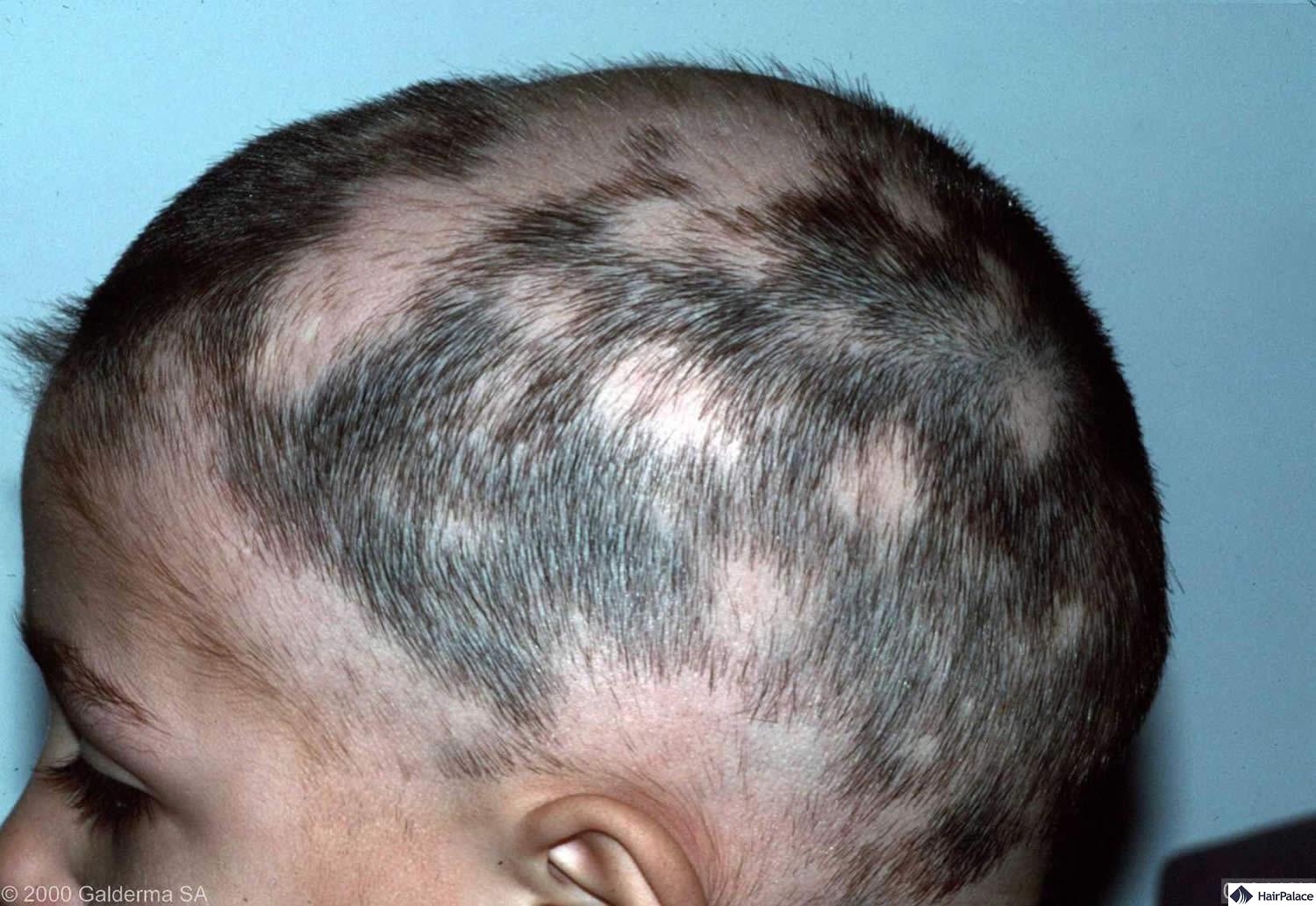
Alopecia areata is an autoimmune disorder that causes sudden, patchy hair loss on the scalp and other areas of the body.
According to the National Institute for Health and Care Excellence (NICE), it affects up to 15 in every 10,000 people in the UK.
What starts as small patches of hair loss can develop into complete hair loss on the scalp, facial area, and across your body.
In this article, we’ll explore everything you need to know about alopecia areata.
We’ll go over the stages, available treatments, and how to alleviate symptoms and stimulate your hair to regrow quicker and stronger than before.
What is alopecia areata?
Alopecia areata is an autoimmune disorder that sees your body’s own defences mistakenly attack hair follicles.
This causes them to shrink and dramatically slows down hair growth and production. Hair falls out in patches, usually the size of a small coin.
The severity of the condition varies between patients. Sometimes it is unnoticeable when alopecia areata occurs.
Other times, however, isolated patches can connect and create noticeable hair loss across your scalp.
Although most cases occur on the scalp, several subtypes of alopecia areata are known to affect eyebrows, eyelashes, facial hair, and body hair.
Alopecia barbae for example is known to mainly affect the beard and facial area.
Finally, alopecia areata can stop at any time, and hair will gradually regrow. But it can return after several months or years.
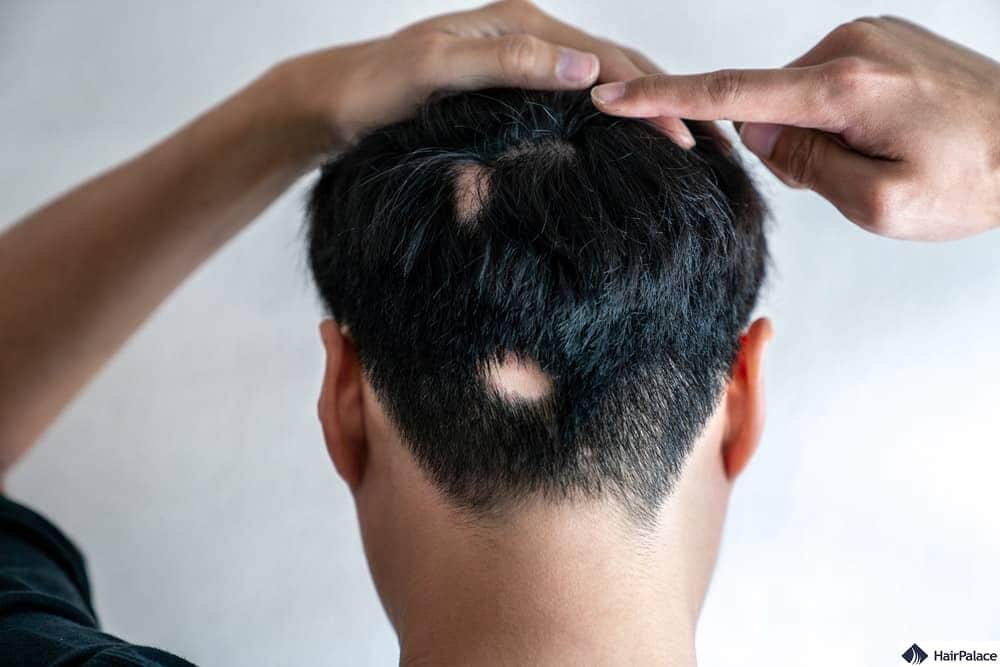
What causes alopecia areata?
Although researchers are still investigating the root cause of alopecia areata, they theorize that a family history of autoimmune diseases can increase your likelihood of being a victim.
Environmental factors may also impact your developing symptoms, including suffering from prolonged stress, a poor diet, suffering hair trauma, and certain medications.
Similar to any other autoimmune disorder, there may be specific behaviors that cause the condition to resurface.
You will only begin to recognize what could potentially cause these upsets by examining your lifestyle.
What are the symptoms of alopecia areata?
Of course, the primary symptom of alopecia areata is hair loss.
This starts in small patches across your scalp but may also affect facial hair, eyelashes, and eyebrows.
There should be no rash, redness, or any signs of trauma on the bald patches of your skin. Instead, it should be smooth.
Patients do report a tingling, itchy, or burning sensation just before the hair falls out – this is your own body’s cells attacking follicles.
Besides the noticeable hair loss, there are some other symptoms you should take note of, including:
- Patches are growing larger and are beginning to connect to each another
- Hair grows back in one spot but falls out in another
- Sudden, substantial, and unexplained hair loss – especially in cold weather
- Fingernails and toenails suffer – becoming red, brittle, and pitted.
- Inflamed and itchy scalp
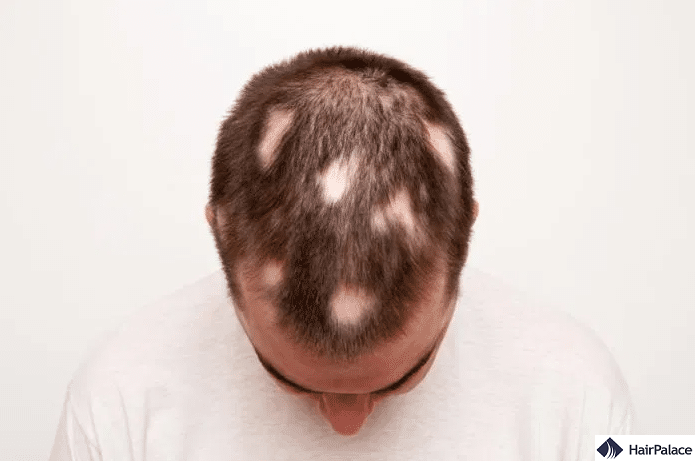
How does alopecia areata affect men?
Alopecia areata can substantially impact men, who stand to lose hair not only on their scalp but their back, chest, and facial area.
Men have a higher chance of developing the condition if someone else in their family has been affected.
How does it affect women?
Although women’s symptoms aren’t as severe, they are, in fact, more likely to suffer from alopecia areata. Scientists are still unsure why this is the case.
Symptoms include thinning hair or developing small bald patches that, over time, could combine into more severe-looking hair loss.
How does it affect children?
Alopecia areata can develop in a person, irrespective of their age.
And just because parents don’t show signs of the condition doesn’t mean children won’t develop the condition, anyway.
But children’s bodies are different from ours, and alopecia areata can come with more severe symptoms around the body.
These may include nail defects such as lesions and pitting and a dramatic drop in self-esteem and self-confidence.
That said, the National Alopecia Areata Foundation has stated that children who suffer from the condition are under five years old report no emotional changes.
How long does an episode of alopecia areata last?
The bald spots developed from alopecia areata typically last a few months to a year. After this, most people see hair regrowth at these sites.
New hair often grows incredibly fine, fluffier, or less pigmented than previously.
These changes should reverse over time, and you will see your standard colour and texture return. Be patient.
Some severe alopecia areata cases will see bald spots continue to grow, eventually connecting and forming a substantial area of hair loss.
This may continue until all hair on your scalp has fallen out (called alopecia totalis) or even your entire body (called alopecia universalis).
It is crucial to keep in mind these extreme cases are very rare.
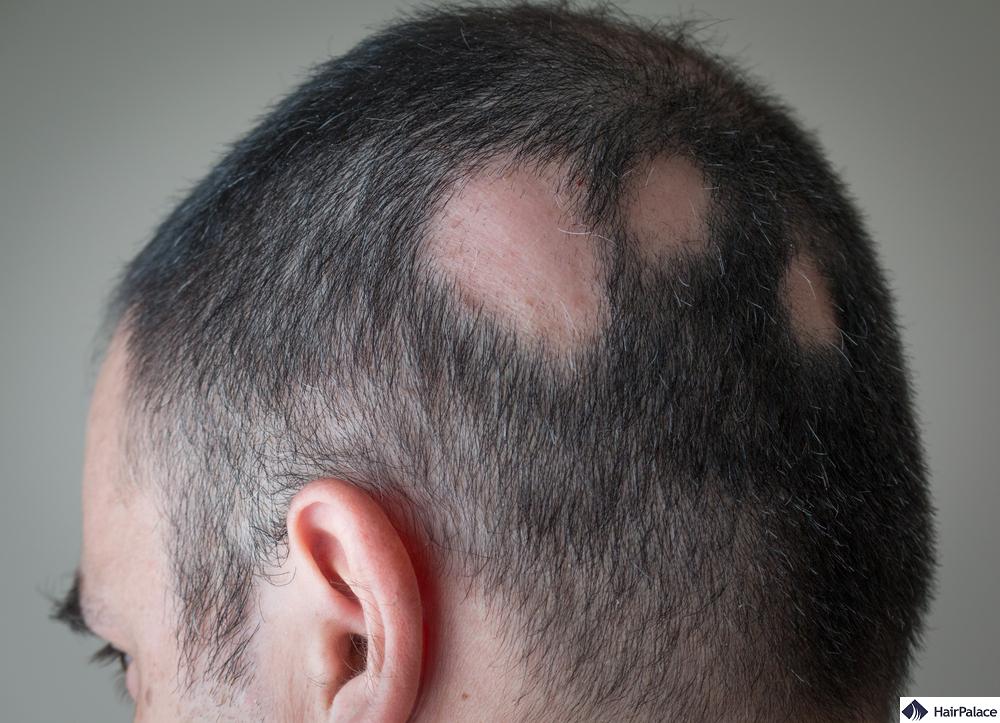
Is there a cure for alopecia areata?
Unfortunately, there is no cure for alopecia areata at this time.
As such, you may have to regularly monitor your scalp to gauge the severity of your condition.
That said, there are potential treatments that can help reduce hair loss during shedding, aid recovery, and improve your scalp’s overall health.
Alopecia areata treatment
There is a range of medical treatments available for alopecia areata sufferers.
That said, every patient responds differently to these treatments, and you may need to try several to see what they can do for you and your scalp.
The most popular treatments include:
- Corticosteroids: More commonly known as steroids, corticosteroid products have anti-inflammatory properties, which can help reduce inflammation at the hair follicle. They often come as creams and lotions.
- Topical immunotherapy: This treatment involves applying diphencyprone, a powdery substance that triggers an allergic reaction on your scalp. This reaction can help stimulate hair growth at a hair follicle, though it may take up to six months to manifest.
- Anthralin: Similarly, anthralin causes skin irritation that can trigger hair to regrowth.
- Minoxidil: Topical minoxidil (also known as Rogaine) is an over-the-counter treatment applied directly to hair loss areas. It shortens the resting phase of hair follicles, causing them to enter the growing stage quicker. It is less effective in treating extensive alopecia areata.
- Cortisone tablets: As an oral treatment, cortisone tablets are effective at rerating advanced alopecia areata. These tablets have side effects, including sleep problems, headaches, and confusion.
- Oral immunosuppressants: As alopecia aerate is an autoimmune disease, oral therapies like cyclosporine or methotrexate aim to block attacks from your immune system. They also have significant side effects, like kidney damage, that a doctor must monitor.
- Light therapy: Also known as photochemotherapy or phototherapy, it combines ultraviolet light and psoralens (an oral medication) to alleviate symptoms.
- Steroid injections: You may be able to regrow hair by injecting steroids directly into affected areas. To achieve results, this must be performed regularly (once per month or every two months)

What natural and alternative treatments are available to you?
Medical treatments aren’t for everyone. They might be expensive, have side effects, or haven’t worked for you in the past.
There are a variety of natural alternatives that you might consider. Some of the most popular include:
- Physical options include acupuncture, microneedling, and scalp massages
- Hair growth oils (e.g., peppermint, lavender)
- Changing or restricting your diet (e.g., autoimmune protocol)
- Low-level laser therapy (LLLT)
- Probiotics
- Hair growth vitamins and minerals
It is important to stress that alternate therapies lack concrete scientific studies to measure their effectiveness.
Results can vary between patients, and what works for someone may not necessarily work for you.
Lastly, regrowth from alternative therapies may be temporary, and as soon as you stop treatments, your hair may return to its previous state.
Will hair grow back after having alopecia?
Mild alopecia areata often recovers within a few months to a year without any treatment.
If hair loss is less than half the scalp and you’ve received no treatments, there’s an 80% chance of complete hair regrowth.
Some people who suffer extensive hair loss may experience patchy baldness sporadically, with the size and severity varying with each flare-up.
And if the hair loss is extensive, it may be unlikely hair will return to its former glory.
The most common signs of regrowth:
- White hair: Although hair grows back generally in most scenarios, sometimes small patches may grow back white. This is a regular occurrence and is not a sign of anything malicious.
- Texture change: new hair regrowth is often fine in texture. These are ‘baby-like’ hairs called vellus hair. These hairs might cover part or all of your bald patches. When vellus hair grows thick, this signals the end of the alopecia flare-up.
- Reduced number of exclamation mark hairs: Like the “!” symbol, exclamation mark hairs are wider at the top and grow thinner closer to the skin. Having these hairs appear during regrowth shows there’s still some resistance to healthy hair regrowing, and your body’s immune system is still affecting hair follicles.
Will alopecia areata hair loss occur again after regrowing?
Unfortunately, there is no guarantee you won’t suffer future hair loss at the hands of alopecia areata.
Some sufferers may experience repeated hair loss months or even years after recovery.
You must remember that alopecia areata, like all autoimmune diseases, has the potential to return if triggered or aggravated.
When this happens, bald patches and hair thinning may resurface.
The 6 types of alopecia areata
There are different forms of alopecia areata, defined by the severity of the condition and if additional symptoms are present or not.
For this reason, your treatment may depend upon which stage you fall under. They are:
1. Alopecia areata
Standard alopecia areata is defined by having at least one patch of hair loss.
The patch is about the size of a small coin and can be found on your scalp and other body parts.
This stage of alopecia can develop into different forms, including alopecia areata totalis and universalis.
2. Alopecia areata totalis
This condition is when you suffer total hair loss across your entire scalp.
3. Alopecia areata universalis
In this form, you will lose all the hair on your body, including eyebrows, eyelashes, across your chest, and pubic hair.
4. Diffuse alopecia areata
Diffuse alopecia areata leads to sudden hair loss of your whole scalp, not just small patches. It resembles female and male pattern baldness.
5. Ophiasis alopecia
This type of alopecia has a unique hair loss, affecting the lower back and sides of the head instead of the top of your head.
6. Alopecia areata incognita
This is the least common subtype of patchy alopecia areata.
It resembles telogen effluvium (hair thinning and shedding) and produces distinctive yellow dots along the affected areas.
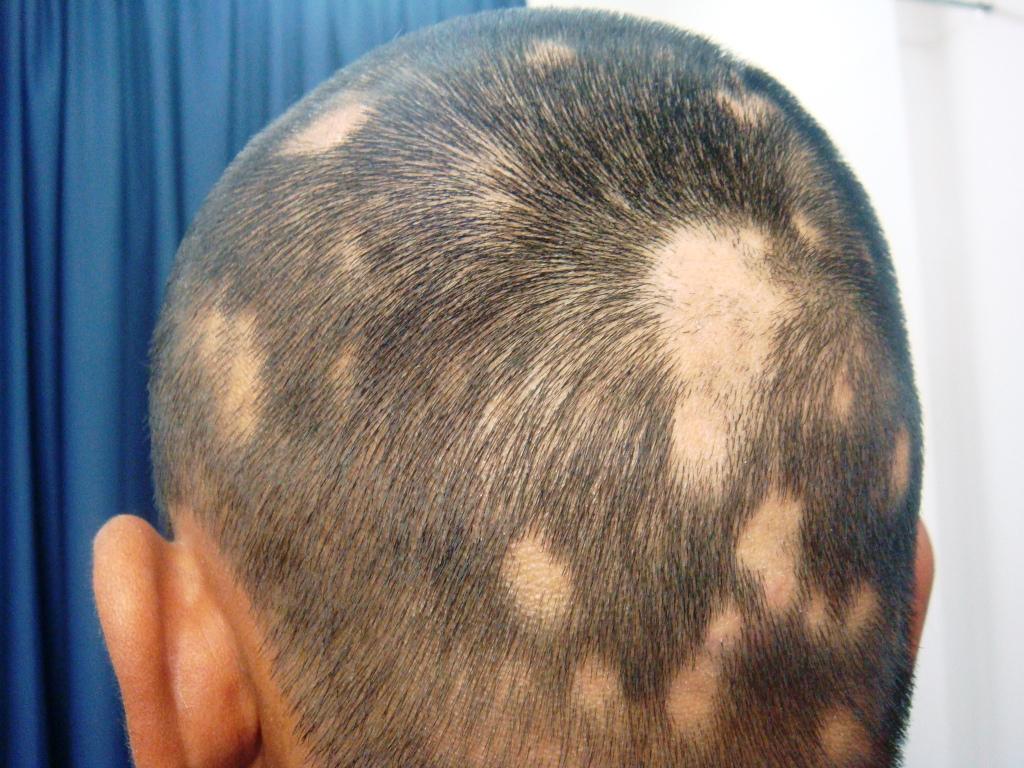
What can you do to prevent alopecia areata?
Unfortunately, scientists are still trying to discover the exact causes of alopecia areata.
At the moment, preventing such a condition is incredibly difficult.
That said, some factors which may influence the development of alopecia include:
- Autoimmune disorders
- Skin diseases
- A family history of the condition
That said, even if you suffer from one of the above, this doesn’t necessarily mean you will suffer alopecia areata.
The only way to properly diagnose your hair and assess your likelihood of hair loss is to attend a hair specialist consultation or discuss your health concerns with your doctor.
Things to avoid when you have alopecia areata
Although the causes of the condition are still being uncovered, there are things you should avoid to improve your scalp hair and protect it from unnecessary harm.
- Elements: As with any hair loss, the first thing you should do is protect your skin from the elements. This includes applying sunscreen wearing protective coverings during sunny weather, and keeping yourself warm during cold weather.
- Reduce stress: When stressed, our hair enters its resting phase earlier than intended. This, in turn, can lead to thinning and early hair loss. Only by reducing stress can you negate this factor. You can try yoga, meditation, and mindfulness exercises to help manage your stress levels.
- Avoid harmful hairstyles: When suffering hair loss, you must avoid hairstyles and beauty techniques that add undue stress to vulnerable hair.
- Diet: It is thought that because it is an autoimmune condition, certain foods may trigger bad reactions like inflammation in your body. Avoiding certain foods with eggs, sugar, or additives, as well as alcohol and caffeine, may help alleviate symptoms. You can reintroduce them one by one back into your diet to determine which if any triggers a reaction.
How to stop alopecia areata from spreading or worsening
The first step to stopping alopecia areata in its tracks is to consult with a haircare specialist or dermatologist to diagnose your condition correctly.
They will assess what stage you are in and examine possible triggers to what’s causing the hair loss in the first place.
They will also recommend lifestyle changes and therapies to alleviate symptoms.
In the meantime, you should avoid excessive hair or scalp treatments and unnecessary trauma like hair pulling or hair styling.
Substitute shampoos and conditioners with harsh ingredients for natural alternatives.
It would help if you tried to eat a balanced diet, ensure you get enough sleep at night, and reduce your everyday stress levels.
How do doctors diagnose alopecia areata?
First, your doctor will take a close look and examine your scalp and the general condition of your hair.
They may take a skin sample to send for further testing to see if the cause of your hair loss can be determined.
They may also take a blood sample to see if an autoimmune response triggers your alopecia.
If your blood sample contains unusual antibodies, this typically points to an autoimmune disease attacking your hair follicles.
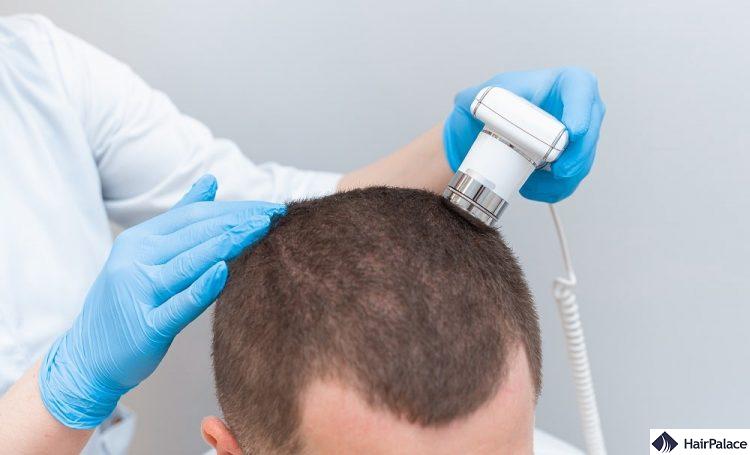
Conclusion
As with all kinds of hair loss, alopecia areata can be a devastating condition to suffer from.
Sudden hair loss in big patches around your head can rob you of your confidence and make you think there’s something drastically wrong with your health.
Without concrete studies, we cannot say for sure how effective treatments are for this type of hair loss.
They work for some people and do not affect others; sometimes, the hair that regrows only stays if you continue treatment.
Hair can regrow by itself, too. All you need to do is give it time.
Remain calm, think positively, and make small lifestyle changes to help support your hair throughout your recovery.
Alopecia Areata FAQ
Those who suffer from it can consider the Autoimmune Protocol (AIP) elimination diet, which aims to reduce inflammation throughout the body. This specialized diet cuts out, among others, dairy, coffee, alcohol, sugar and grains. Over time you will gradually reintroduce these foods one by one to determine which food could potentially be causing you a bad reaction.
This is an autoimmune disease, similar to diabetes and thyroid disease. Your own immune system mistakes hair follicles as invaders and attacks them. This can result in dramatic hair loss and inflammation, forming the condition we know of as alopecia areata.
The first sign is a circular bald patch developing on your scalp. This can take a couple of weeks, with regrowth expected within several months.
According to NICE, about 15 in every 10,000 people suffer from this disease. The condition does not discriminate between men and women and can affect you at any age.
Last medically reviewed on January 2nd, 2025
- Muller, SIGFRID A., and R. K. Winkelmann. "Alopecia areata: an evaluation of 736 patients." Archives of Dermatology 88.3 (1963): 290-297.
- Fiedler-Weiss, Virginia C., and Cunera M. Buys. "Evaluation of anthralin in the treatment of alopecia areata." Archives of dermatology 123.11 (1987): 1491-1493.
- Garg, Seema, and Andrew G. Messenger. "Alopecia areata: evidence-based treatments." Seminars in cutaneous medicine and surgery. Vol. 28. No. 1. No longer published by Elsevier, 2009.
- McDonagh, A. J. G., and A. G. Messenger. "The pathogenesis of alopecia areata." Dermatologic clinics 14.4 (1996): 661-670.
- Messenger, A. G., D. N. Slater, and S. S. Bleehen. "Alopecia areata: alterations in the hair growth cycle and correlation with the follicular pathology." British Journal of Dermatology 114.3 (1986): 337-347.
- Dainichi, Teruki, and Kenji Kabashima. "Alopecia areata: what’s new in epidemiology, pathogenesis, diagnosis, and therapeutic options?." Journal of Dermatological Science 86.1 (2017): 3-12.
- Hussain, Salman T., et al. "Utilization of mental health resources and complementary and alternative therapies for alopecia areata: A US survey." International journal of trichology 9.4 (2017): 160.


